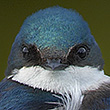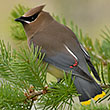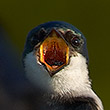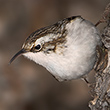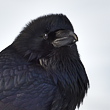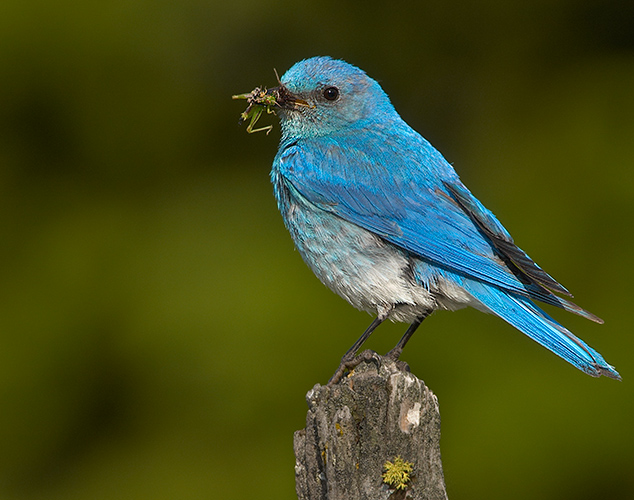
Availability: Undetermined - Enquiries?
In the Field
Mountain Bluebird with Bug Findlay Creek, BC, Canada. June 10, 2007.
Male Mountain Bluebirds have brilliantly coloured plumage, especially when caught in full sunlight. Many birds have colour which is supplied by pigments (such as melanins, carotenoids, and porphyrines). Other birds, including Mountain Bluebirds and Hummingbirds, get their colouration not from pigments but directly from the structure of their feathers. In these birds, the colour comes from the refraction of incident light caused by the microscopic structure of the feathers. Tiny air pockets within the barbs of the feathers scatter the incoming light, which results in the non-iridescent colour of blue.
Huh? Why is this important for a photographer? One consequence is that unlike in some other birds (such as waxwings), this scattering of light not only produces pleasing colour, but also can enhance the contrast between the barbs, producing exceptionally detailed views of the feathers. Add supplemental light (like a camera's flash) and you can end up with an image than can, in certain situations, appear to be "super" sharp, almost as though the image was oversharpened on your computer. Which is exactly what you see above - an image with NO in-camera sharpening and almost no sharpening during the processing of the image. Yet the detail is amazing (I wish you could see this image at full size - the detail is nothing short of stunning!).
Oh yeah, and the bird is carrying one mighty ugly bug! But, I'm sure the "kids" don't mind!
Behind the Camera
Mountain Bluebird with Bug Findlay Creek, BC, Canada. June 10, 2007.
Digital Capture; Uncompressed RAW (NEF) format; ISO 100.
Nikon D2Xs with with Nikon 200-400 mm f/4G ED-IF AF-S VR lens @ 400 mm paired with 1.4X Nikon TC-14E II teleconverter (825 mm equivalent with digital conversion factor) supported on Gitzo 1348 carbon fibre tripod with Wimberley head. VR turned to "On" and in "Normal" mode. SB-800 flash (fill) with Better Beamer Flash Extender mounted on Really Right Stuff flash bracket.
1/160s @ f9; -0.67 stop exposure compensation from matrix-metered exposure setting; balanced i-TTL flash exposure with -1.0 stop compensation on SB-800.
At the Computer
Mountain Bluebird with Bug Findlay Creek, BC, Canada. June 10, 2007.
RAW Conversion to 16 bit TIFF, including first-pass sharpening, exposure compensation, and tone curve adjustment, using Phase One's C1 Pro.
Further digital correction on 16-bit TIFF file using Adobe's Photoshop CS3 and LightZone 3. Minor tonal adjustments performed in LightZone (using the ToneMapper/Relight tool). Photoshop adjustments included selective colour desaturation (really!), and very minor and very selective sharpening for web output.
Conservation
Mountain Bluebird with Bug Findlay Creek, BC, Canada. June 10, 2007.
Ten percent of the revenue generated by this image will be donated to Wildsight.
Species Status in Canada*: This species is not designated as at risk.
The Mountain Bluebird (Sialia currucoides) is a brilliantly coloured thrush found over much of western North America. Despite its name, it is NOT limited in distribution to mountain regions. In the early 1900's Mountain Bluebird populations plummeted due to loss of nesting habitat (natural cavities) due to the introduction of alien species, including House Sparrows and Starlings. An aggressive conservation effort in the form of the introduction of species-specific nest boxes worked and today bluebirds are common again.
This male Mountain Bluebird was photographed in the Columbia Valley of the East Kootenays. Many ecosystems within the Columbia Valley face development pressure, including pressure from logging operations. While Mountain Bluebirds are not directly threatened in the Columbia Valley, they do, of course, need appropriate habitat in order to continue to thrive. Wildsight is an effective conservation organization that protects biodiversity and promotes sustainable communities in Canada's Columbia and Rocky Mountains. Support for Wildsight, through donation or becoming a member, will help ensure that they remain effective in their efforts to conserve threatened or endangered species and ecosystems.
*as determined by COSEWIC: The Committee on the Status of Endangered Wildlife in Canada



















